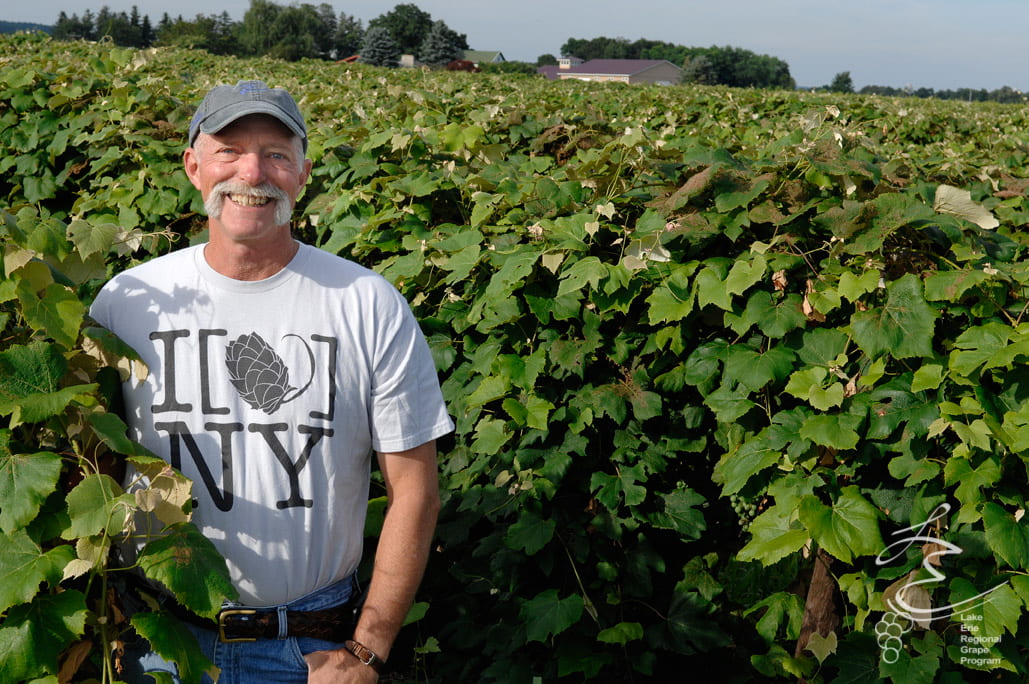
(Above) Two splendid September days saw many visitors to our Open House and Twilight Field Day. Master Gardeners, growers, and researchers chatted with NYSIPM staff about our Christmas tree research and wildflower plots. Can establishing pollinator and natural enemy habitat also reduce pest problems? We’re finding out. Project Leaders: Amara Dunn, Elizabeth Lamb, Brian Eshenaur.
This new blog series will highlight the stories we were proud to share in our latest annual report! Download the entire report brochure here.

Director’s Message
With new arrivals like the Asian longhorned tick, New York’s pest problems are everchanging; so is pest management. Crop production, tillage, pruning and harvesting practices all look different than a generation ago. Old, broad-spectrum chemical pesticides are giving way to biologically-based and species-specific products. But IPM principles are just as relevant today as they were when the concept of IPM was developed over a half century ago. For example …
Prevention: Together with our state agency partners, we’re holding off the introduction of spotted lanternfly into New York, while preparing growers for its eventual arrival.
Monitoring: Our network for environment and weather applications (NEWA) is more in demand than ever, incorporating weather data into pest prediction models.
Risk Reduction: Two decades of researching and teaching low chemical use practices on state park golf courses, and measuring environmental impact, have made us national leaders in risk reduction in golf.
Decision-making and record keeping: Our apps for sweet corn, hops, and conifers will soon join those we created for greenhouse biocontrol, western bean cutworm, and field crops scouting.
Non-chemical control: We’re testing and teaching cultivation and cover cropping for weed management, and raising awareness of biological control approaches.
Protecting non-target organisms: IPM goals of protecting humans, wildlife, pets, and beneficial organisms—including pollinators—are alive and well.
IPM is perpetually new and fresh, and ready to address today’s challenges on farms and in communities. Please read on and learn what the New York State IPM Program (NYSIPM) has been up to lately.
Three Decades of Successful Grape IPM
Thirty years ago, New York State grape growers faced an out-of-control pest, the grape berry moth (GBM)—despite four or five insecticide sprays a year. After developing a new IPM protocol for assessing GBM risk and managing the pest, researchers needed someone to show growers how to use it in their vineyards. That’s when, funded by the state, NYSIPM hired its first grape IPM specialist. Once on board, Tim Weigle demonstrated research-based techniques for GBM management to growers in the Lake Erie Region. The program was a wild success. Weigle got growers’ sprays down to one or none by applying Cornell IPM know-how. And the crop? Virtually moth-free.

Over the decades, Weigle went on to develop, test, and teach solutions for a myriad of insect, disease, and weed problems in vineyards—not just in NYS, but across the Great Lakes region. He reached over 1,500 growers, processors, and fruit workers annually. How? Via educational meetings, workshops, webinars, podcasts, videos, and newsletters. Likewise, Weigle helped colleagues develop IPM guidelines, field guides, record-keeping software, and most recently collaborated on digital vineyard management tools.
In 1992, Weigle helped develop NEWA, the Network for Environment and Weather Applications. Today, weather stations live-stream data to inform IPM forecasts that address the five main threats to vineyard health. NEWA’s online network gives up-to-the-minute decision support so growers know when their crops are at risk—or not—thereby reducing extra sprays. Weigle ushered in e-NEWA, directly delivering NEWA results to growers by email, and in 2019 he doubled Lake Erie weather stations to 44, bringing IPM forecasts to even more grape growers.
Most recently, as the threat of the spotted lanternfly (SLF) looms across New York, Weigle brought his entomology and education skills to the forefront again, leading NYSIPM’s SLF awareness and outreach campaign. And his perceptive people-skills remind us that it’s not just vineyard managers who need to be vigilant, but every traveler passing through the SLF-infested areas to our south. Weigle has just retired, leaving large shoes to fill in grape IPM.
Grape and Hops IPM Extension Educator Tim Weigle, like some of the pests he helped growers successfully manage, is now a rare sight out in the field. His 2019 retirement from NYSIPM means more than an empty desk at the Lake Erie Research and Extension Lab, his base since its opening ten years ago. For 30 years, Tim partnered with researchers, growers, and industry to protect New York’s land and water. We hope Tim is now enjoying the fruits of his labor, literally!
For more on any aspect of the New York State Integrated Pest Management Program, please visit our website!